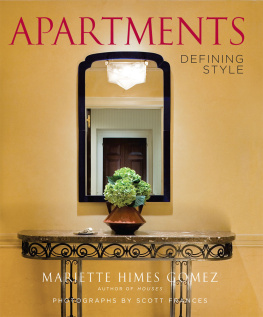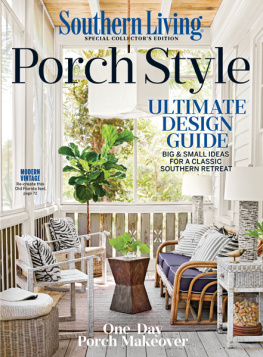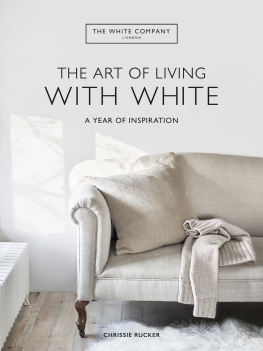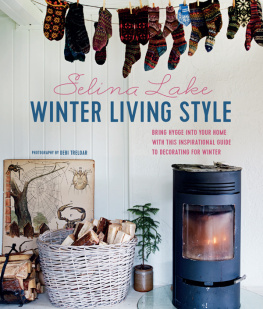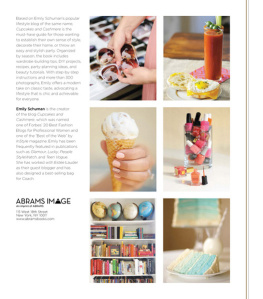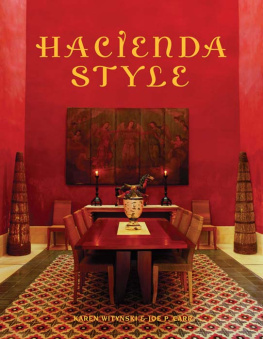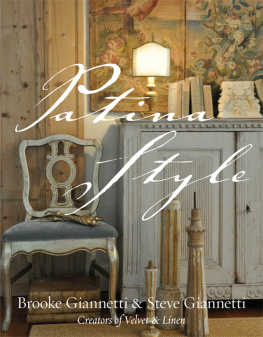I dedicate this book to all my wonderful clients;
you know who you are.


Growing up in a house in Michigan, the idea of living in an apartment seemed impossibly glamorous. The images in my head came straight out of the movies. Even now, I can think of several enticing examples of New York real estate that could convince me to pack my bags and move right in: Dick Powell and Myrna Loys art deco charmer in The Thin Man , Katharine Hepburn and Spencer Tracys Turtle Bay duplex in Adams Rib , Mia Farrows rambling wood-paneled Central Park West apartment in Hannah and Her Sisters , even Audrey Hepburns barely furnished third-floor walk-up in a townhouse on the Upper East Side. Well, maybe not the walk-up.
But as someone who has lived both in houses and apartments, I can say there are some advantages to apartment living. In buildings of a certain caliber, packages appear magically at your door. Visitors are announced. A kindly doorman pro-cures taxis and even has an umbrella handy to hold over you in the rain. Unfortunate mishaps involving boilers and leaky pipes are handled by others. There is a staff on hand to see to your needs. My building manager actually helped me trim my Christmas tree when I ran out of time before a party.
Most apartments are found in densely populated urban environments. The apartments shown in this book are mainly in New York, with two forays down to Florida and a jaunt across the Atlantic to London. Some are in mature buildings with elaborate architectural detail. Others are part of newer construction where the architect took a more streamlined approach. Before you begin to decorate, you must read the character of your doors, walls, and windows. Notice where the natural light is coming from. Strong sunlight on a cloudy day can change the colors in an apartments interior. I like to take advantage of this by not doing exaggerated window treatments, as well as providing for ample lamplight to compensate for the cloudy or rainy days.


Apartments often have more enclosed space than houses, and there are tricks that can make them feel a little more expansive. If you can create a connecting threadsuch as doors that align so your eye goes to the farthest pointyou can make a space seem larger. A narrow hallway that leads into a larger bedroom will make that bedroom feel so much loftier. Yet the most important trick has nothing to do with doors and walls and does not require a contractor. It involves only you. You must learn how to edit your possessions. Any room, small or large, will appear smaller if it is cluttered. Keep it simple, and your apartment will feel like a bigger box.
The first thing to do, even before you begin decorating, is to decide how you want to use a room. Will this be a private retreat or a space that should accommodate large groups of people? That will help deter-mine the design. I love mixing styles of the past with those of the present. I think rooms, particularly in an apartment, are more interesting and inviting if this is done well. Dont be afraid to hang a contemporary painting over a Chippendale chair.
When purchasing furniture, strive for lasting qualityunless your personality requires constant change. If this is the case, I would still advise you to invest in serious staples and then feel free to play with the accessories around them. Changing a wall color or a window curtain is often easier than replacing a dining table or a sofa. These large objects are difficult to get in and out of an apartment and often involve special delivery charges. If you do decide to replace furnishings, give them a second life in that extra room, the kitchen, or the bath.
Consider how color and texture on walls, trim, ceilings, floors, and upholstery will contribute to the mood. I like to mix various tones of the same pale colors to create calm. Strong, bold colors can be very effective, but be aware that they can also make a room feel smaller.
Adequate lighting is essential if you want all your best efforts to show. Never underestimate the value of a table or floor lamp. Im a firm believer in dimmer switches, one of the quickest ways to create atmosphere in even the smallest space.
Tabletops are another opportunity to add interest and build character. Display objects that matter to you. The idea is to create a multilayered space that is steeped in personality. Details matter. Decorating actually starts at the front door, with the doorknob. Pay attention to everything your hand will touch.
If you need motivation before starting your own project, you might try a little research. Take a class in furniture styles, or thumb through books on color. Anyone can learn how to draw a rudimentary floor plan. If all this sounds too complicated, simply get out a DVD. Study the sets in early black-and-white movies or extravagant films like Marie Antoinette or The Mad-ness of King George . Somehow they always strike an intriguing note of color, drama, and mood.


Still searching for inspiration? Just turn the page.

Theres nothing complicated about this arrangement of furnituretwo matching sofas and a cane-back chair. While I didnt want to take your attention away from the beautiful walls, I couldnt resist one amusing detailthe luxurious bullion fringe, which makes the sofas feel very French.
I f, like these clients, youre lucky enough to own an apartment in one of the great New York apartment houses designed by Rosario Candela in the 1920s, half my job is already done. I wont have to rework the architecture because it will already be superb. The windows will stretch to the floor, with French doors opening onto a balcony that makes you feel as if youre in Paris. The ceilings will be elegantly high, and the proportions of the rooms will be gracious.
Yet this apartment had something even more unusual. The living room walls had been painted in the most extraordinary faux finish to mimic burled wood. Look at the grain! Youd think it was real. But the wife was worried. She was afraid the room was too dark, but her husband didnt want to change it. He was relying on me to make it right. As we went back and forth about whether the faux paneling should stay or go, my mind was racing. I said, Lets make the whole apartment all about dark and light. The walls are dark, but everything else will be light.
Now the entrance hall is a serene white, which sets the stage for that magnificent trompe loeil paneling. In an apartment, the first real opportunity for impact is just inside the front door, and I always try to make the most of it. What emotion do you want people to feel? I wanted a guest to feel tranquil and calm, and then be struck by the drama of that dazzling faux paneling. The entrance hall is very plain, so as not to compete. The only furniture is an English mahogany bench, where you could set down a briefcase, under the curve of the staircase. All those lovely staircases in Manhattan duplex apartments feel like movie sets to me.

